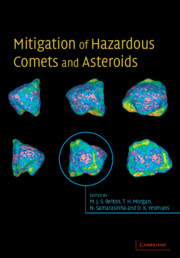Book contents
- Frontmatter
- Contents
- List of contributors
- Preface
- Acknowledgments
- Glossary
- 1 Recent progress in interpreting the nature of the near-Earth object population
- 2 Earth impactors: orbital characteristics and warning times
- 3 The role of radar in predicting and preventing asteroid and comet collisions with Earth
- 4 Interior structures for asteroids and cometary nuclei
- 5 What we know and don't know about surfaces of potentially hazardous small bodies
- 6 About deflecting asteroids and comets
- 7 Scientific requirements for understanding the near-Earth asteroid population
- 8 Physical properties of comets and asteroids inferred from fireball observations
- 9 Mitigation technologies and their requirements
- 10 Peering inside near-Earth objects with radio tomography
- 11 Seismological investigation of asteroid and comet interiors
- 12 Lander and penetrator science for near-Earth object mitigation studies
- 13 Optimal interception and deflection of Earth-approaching asteroids using low-thrust electric propulsion
- 14 Close proximity operations at small bodies: orbiting, hovering, and hopping
- 15 Mission operations in low-gravity regolith and dust
- 16 Impacts and the public: communicating the nature of the impact hazard
- 17 Towards a national program to remove the threat of hazardous NEOs
- Index
1 - Recent progress in interpreting the nature of the near-Earth object population
Published online by Cambridge University Press: 12 October 2009
- Frontmatter
- Contents
- List of contributors
- Preface
- Acknowledgments
- Glossary
- 1 Recent progress in interpreting the nature of the near-Earth object population
- 2 Earth impactors: orbital characteristics and warning times
- 3 The role of radar in predicting and preventing asteroid and comet collisions with Earth
- 4 Interior structures for asteroids and cometary nuclei
- 5 What we know and don't know about surfaces of potentially hazardous small bodies
- 6 About deflecting asteroids and comets
- 7 Scientific requirements for understanding the near-Earth asteroid population
- 8 Physical properties of comets and asteroids inferred from fireball observations
- 9 Mitigation technologies and their requirements
- 10 Peering inside near-Earth objects with radio tomography
- 11 Seismological investigation of asteroid and comet interiors
- 12 Lander and penetrator science for near-Earth object mitigation studies
- 13 Optimal interception and deflection of Earth-approaching asteroids using low-thrust electric propulsion
- 14 Close proximity operations at small bodies: orbiting, hovering, and hopping
- 15 Mission operations in low-gravity regolith and dust
- 16 Impacts and the public: communicating the nature of the impact hazard
- 17 Towards a national program to remove the threat of hazardous NEOs
- Index
Summary
Introduction
Over the last several decades, evidence has steadily mounted that asteroids and comets have impacted the Earth over solar system history. This population is commonly referred to as “near-Earth objects” (NEOs). By convention, NEOs have perihelion distances q ≤ 1.3 AU and aphelion distances Q ≥ 0.983 AU (e.g., Rabinowitz et al. 1994). Sub-categories of the NEO population include the Apollos (a ≥ 1.0 AU; q ≤ 1.0167 AU) and Atens (a < 1.0 AU; Q ≥ 0.983 AU), which are on Earth-crossing orbits, and the Amors (1.0167 AU < q ≤ 1.3 AU) which are on nearly-Earth-crossing orbits and can become Earth-crossers over relatively short timescales. Another group of related objects that are not yet been considered part of the “formal” NEO population are the IEOs, or those objects located inside Earth's orbit (Q < 0.983 AU). To avoid confusion with standard conventions, we treat the IEOs here as a population distinct from the NEOs. The combined NEO and IEO populations are comprised of bodies ranging in size from dust-sized fragments to objects tens of kilometers in diameter (Shoemaker 1983).
It is now generally accepted that impacts of large NEOs represent a hazard to human civilization. This issue was brought into focus by the pioneering work of Alvarez et al. (1980), who showed that the extinction of numerous species at the Cretaceous–Tertiary geologic boundary was almost certainly caused by the impact of a massive asteroid (at a site later identified with the Chicxulub crater in the Yucatan peninsula) (Hildebrand et al. 1991).
Information
- Type
- Chapter
- Information
- Mitigation of Hazardous Comets and Asteroids , pp. 1 - 21Publisher: Cambridge University PressPrint publication year: 2004
Accessibility standard: Unknown
Why this information is here
This section outlines the accessibility features of this content - including support for screen readers, full keyboard navigation and high-contrast display options. This may not be relevant for you.Accessibility Information
- 5
- Cited by
